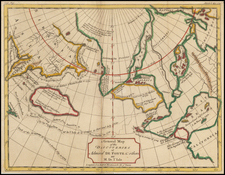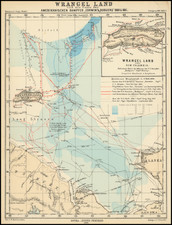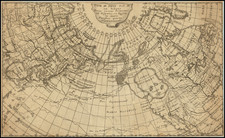Remarkable large format map of Alaska, published shortly after the discovery of gold in the Klondike Region.
Fascinating early map, published to capitalize on interest in the gold regions. This example bears the imprint "transferred to stone and printed by Andrew B. Graham."
First published in 1890 and periodically updated thereafter, this example was apparently hurriedly re-issued to provide early gold seekers with a large format map of the region.
The present map includes an overprinted location of the Klondike Region. It is quite possible that this is one of the earliest obtainable maps to promote the discovery of Gold in the Klondike Region, as very soon thereafter, Rand McNally was printing its own guide book maps which were much more specifically intended to illustrate and describe the gold regions in Alaska and the Klondike.
Rand McNally & Co. is a large American map and navigation company best known for its annual atlases. The company got its start in 1856, when William Rand opened a print shop in Chicago. He was joined in 1858 by a new employee, Andrew McNally. Together, the men established their namesake company in 1868. Originally, the company was intended to print the tickets and timetables for the trains running to and through Chicago; their first railway guide was published in 1869.
By 1870, they had shifted from just printing to publishing directories, travel guides, and newspapers. Their first map appeared in 1872 in a railway guide. The map was produced using a new wax engraving method, a cheaper process that gave the company an edge.
By 1880 Rand McNally had entered the education market with globes, wall maps, and geography texts for students. In 1923, Rand McNally published the first Goode’s World Atlas, named after its editor, Dr. J. Paul Goode. For generations afterward, this would be the standard classroom atlas.
In 1899, William Rand left the company, but McNally and his family remained, controlling the company for over a century. In 1904, they published their first road map intended for automobiles and by 1907 were publishing Photo-Auto Guides, which combined photography and mapping to help drivers. In 1924, they produced the Auto Chum, a precursor to their famous road atlases. Rand McNally would remain the leader in road maps and atlases throughout the twentieth century.
In 1937, Rand McNally opened its first store in New York City. Ever on the frontier of technology, Rand McNally pioneered the scribing process for printing tickets in 1958 and printed their first full-color road atlas in 1960. Arthur Robinson developed his now-famous projection of Rand McNally in 1969. By the 1980s, the company was exploring digital reproduction and digital databases of maps for truckers. In the 1990s, they lead the charge to develop trip-planning software and websites. Today, most of its products are available online or in a digital format, including maps for tablets and phones.









![[ Alaska ] U.S. Coast Survey — Explorations in Alaska By the Party under the direction of WH. Dall, Assistant. 1874](https://storage.googleapis.com/raremaps/img/small/96642.jpg)

![[ Cook's Discoveries in Russian America ] Chart of the NW Coast of America and the NE Coast of Asia explored in the Years 1778 & 1779 . . .](https://storage.googleapis.com/raremaps/img/small/68831.jpg)
![[ Highlighting Routes To The Gold Regions ] Map of Alaska Compiled from the official Records of the General Land Office, U.S. Coast and Geodetic Survey and other sources . . . 1898](https://storage.googleapis.com/raremaps/img/small/98404.jpg)

